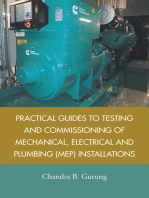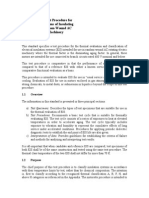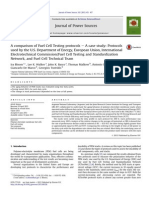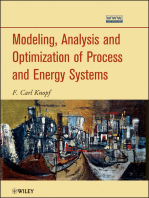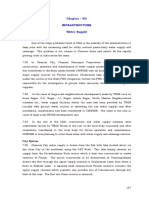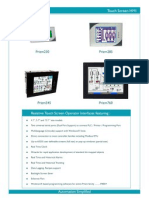0 ratings0% found this document useful (0 votes)
84 viewsAsme Ptc-50: Andrew Skok Director, Field Operations Fuelcell Energy
Asme Ptc-50: Andrew Skok Director, Field Operations Fuelcell Energy
Uploaded by
dreamboy87This document presents ASME PTC-50, a performance test code for fuel cell power systems. The code provides test procedures, methods, and definitions for characterizing the performance of fuel cell power systems. It establishes a test boundary that accounts for all fuel, oxidant, and secondary energy inputs as well as net electrical and thermal energy outputs. Test results are used to determine fuel-to-electrical energy conversion efficiency and overall thermal effectiveness to within 2% uncertainty. The code applies to all fuel cell power systems regardless of size, fuel cell type, or application.
Copyright:
© All Rights Reserved
Available Formats
Download as PDF, TXT or read online from Scribd
Asme Ptc-50: Andrew Skok Director, Field Operations Fuelcell Energy
Asme Ptc-50: Andrew Skok Director, Field Operations Fuelcell Energy
Uploaded by
dreamboy870 ratings0% found this document useful (0 votes)
84 views14 pagesThis document presents ASME PTC-50, a performance test code for fuel cell power systems. The code provides test procedures, methods, and definitions for characterizing the performance of fuel cell power systems. It establishes a test boundary that accounts for all fuel, oxidant, and secondary energy inputs as well as net electrical and thermal energy outputs. Test results are used to determine fuel-to-electrical energy conversion efficiency and overall thermal effectiveness to within 2% uncertainty. The code applies to all fuel cell power systems regardless of size, fuel cell type, or application.
Original Title
Skok
Copyright
© © All Rights Reserved
Available Formats
PDF, TXT or read online from Scribd
Share this document
Did you find this document useful?
Is this content inappropriate?
This document presents ASME PTC-50, a performance test code for fuel cell power systems. The code provides test procedures, methods, and definitions for characterizing the performance of fuel cell power systems. It establishes a test boundary that accounts for all fuel, oxidant, and secondary energy inputs as well as net electrical and thermal energy outputs. Test results are used to determine fuel-to-electrical energy conversion efficiency and overall thermal effectiveness to within 2% uncertainty. The code applies to all fuel cell power systems regardless of size, fuel cell type, or application.
Copyright:
© All Rights Reserved
Available Formats
Download as PDF, TXT or read online from Scribd
Download as pdf or txt
0 ratings0% found this document useful (0 votes)
84 views14 pagesAsme Ptc-50: Andrew Skok Director, Field Operations Fuelcell Energy
Asme Ptc-50: Andrew Skok Director, Field Operations Fuelcell Energy
Uploaded by
dreamboy87This document presents ASME PTC-50, a performance test code for fuel cell power systems. The code provides test procedures, methods, and definitions for characterizing the performance of fuel cell power systems. It establishes a test boundary that accounts for all fuel, oxidant, and secondary energy inputs as well as net electrical and thermal energy outputs. Test results are used to determine fuel-to-electrical energy conversion efficiency and overall thermal effectiveness to within 2% uncertainty. The code applies to all fuel cell power systems regardless of size, fuel cell type, or application.
Copyright:
© All Rights Reserved
Available Formats
Download as PDF, TXT or read online from Scribd
Download as pdf or txt
You are on page 1of 14
ASME PTC-50
PERFORMANCE TEST CODE 50
on
FUEL CELL POWER SYSTEMS
PERFORMANCE
Andrew Skok
Director,Field Operations
FuelCell Energy
PTC-50 Committee Members
David H. Archer, Carnegie Mellon University
Patrick James (Jim) Buckley, Energy Alternatives
Serge Comtois, H Power Enterprises of Canada Inc.
John S. Frick, SCANA Corporation
Kelvin Hecht, UTC Fuel Cells
Franklin H. Holcomb, US Army Corp of Engineers
Jack H. Karian, ASME International
Brennon Knaggs, Ballard Generation Systems
Michael Krumpelt, Argonne National Laboratory
Anthony J. Leo, Fuel Cell Energy
Robert M. Privette, OMG Corporation
Larry A. Shockling, Siemens-Westinghouse Power Corporation
Andrew Skok, alternate, Fuel Cell Energy
Robert P. Wichert, US Fuel Cell Council
Mark C. Williams, US DOE, NETL
OBJECT
This Code provides test procedures, methods and
definitions for the performance characterization of fuel cell
power systems. Fuel cell power systems include all
components required in the conversion of input fuel and
oxidizer into output electrical and thermal energy.
Performance characterization of fuel systems includes
evaluating system energy inputs and electrical and thermal
outputs to determine fuel-to-electrical energy conversion
efficiency and where applicable the overall thermal
effectiveness. These efficiencies will be determined to an
absolute uncertainty of less than ? 2% at a 95% confidence
level.
SCOPE
Applies to all fuel cell power systems regardless of the
electrical power output, thermal output, fuel cell type, fuel
type, or system application.
The net power output and all the fuel input to the system
shall be taken into account in the performance test
calculations.
Applies to the performance of overall fuel cell power
systems.
Addresses combined heat and power systems, that is, the
generation of electricity and usable heat at specific thermal
conditions.
Does not address the performance of specific subsystems
nor does it apply to energy storage systems
SCOPE (cont)
Does not address emissions, reliability, safety issues, or
endurance.
Contains methods and procedures for conducting and reporting
fuel cell system testing, including instrumentation to be used,
testing techniques, and methods for calculating and reporting
results.
Defines the test boundary for fuel and oxidant input, secondary
energy input and net electrical and thermal energy output
Provides procedures for determination of electrical efficiency or
heat rate and overall thermal effectiveness at rated or any other
steady state condition. The Code also provides the method to
correct results from the test to reference conditions.
Fuel Input
Secondary
Energy Input
Oxidant Input
Test Boundary
Net Electrical Energy Output
Thermal Energy Output
Waste Thermal Energy Output
Emissions
Required to be measured for test calculation
Not required to be measured for test calculation
Overall Test Boundary
Fuel
Processor
Oxidant
Input
Fuel Cell
Thermal
DC Power
Thermal Energy
Recovery
Power
Conditioner (s)
Thermal to
Mechanical
Energy
Conversion
Net Electrical
Energy Output
Waste
Energy
Thermal
Energy Output
Mechanical
to Electrical
Energy
Conversion
Fuel
Internal Power
Needs
Shaft
Work
(W)
Fuel
Input
Shaft
Work
Input
Secondary
Energy
Input
Secondary
Thermal
Input
FUEL CELL SYSTEM TEST BOUNDARY
ILLUSTRATING INTERNAL SUBSYSTEMS
0 INTRODUCTION
1 OBJECT AND SCOPE
1.1 Object
1.2 Scope
1.3 Test Uncertainty
2 DEFINITIONS AND DESCRIPTION OF
TERMS
2.1 Introduction
2.2 Fuel Cell Types
2.3 Fuel Cell Power Systems
2.4 General Fuel Cell Nomenclature
2.5 General Definitions
3 GUIDING PRINCIPLES
3.1 Introduction
3.2 Agreements
3.3 Test Boundary
3.4 Test Plan
3.5 Preparation for Test
3.6 Parameters to be Measured or
Determined During the Test Period
3.7 Operation of the Test
3.8 Calculation and Reporting of Results
3.9 Records
4 INSTRUMENTS AND METHODS OF
MEASUREMENT
4.1 General Requirements
4.2 Checklist of Instruments and Apparatus
4.3 Determination of Outputs
4.4 Determination of Fuel Input
4.5 Data Collection and Handling
5 COMPUTATION OF RESULTS
5.1 Introduction
5.2 Computation of Inputs
5.3 Computation of Electric Power Output
5.4 Computation of Thermal and
Mechanical Output
5.5 Computation of Average Net Power
5.6 Computation of Efficiencies
5.7 Correction of Test Results to Specified
or Standard Conditions
6 REPORT OF RESULTS
7 MANDATORY APPENDIX
7.1 Uncertainty Analysis and
Sample Calculations
ASME Board on Performance Test Codes passed
review in early May
Completing Public Review Process:
Notice placed in the Mechanical Engineering magazine,
May 2002 issue, page 63
Also placed in ANSI Standards Action, Vol. 33 #7,
March 28, 2002, page 6.
Comment date ended on May 28, 2002.
Approval request from ANSI to be processed in June
Document should be published this summer
You might also like
- Emergency Response Plan For Construction Site-EditDocument11 pagesEmergency Response Plan For Construction Site-Editdreamboy8790% (10)
- Asset Health IndexDocument15 pagesAsset Health IndexLuv Suneja100% (2)
- Practical Guides to Testing and Commissioning of Mechanical, Electrical and Plumbing (Mep) InstallationsFrom EverandPractical Guides to Testing and Commissioning of Mechanical, Electrical and Plumbing (Mep) InstallationsRating: 4 out of 5 stars4/5 (4)
- Aeronautical Engineering Units 130710Document63 pagesAeronautical Engineering Units 130710maitham1000% (1)
- GE Gas Turbine ControlDocument35 pagesGE Gas Turbine ControlAmpornchai Phupol100% (8)
- Commissioning ScheduleDocument1 pageCommissioning Scheduledreamboy87No ratings yet
- SHE Manual For Construction Contractors-EditDocument79 pagesSHE Manual For Construction Contractors-Editdreamboy87100% (1)
- Unit 5 Let's ExperimentDocument14 pagesUnit 5 Let's ExperimentHyogo Toyo100% (1)
- PR Earth Users Guide EMILY1Document2 pagesPR Earth Users Guide EMILY1Azim AbdoolNo ratings yet
- Technological Development - Health Monitoring - Maximizing Efficiency - Advance Communication System - Regulatory and Environmental IssuesDocument37 pagesTechnological Development - Health Monitoring - Maximizing Efficiency - Advance Communication System - Regulatory and Environmental IssuesAnonymous pKsr5vNo ratings yet
- ASME, Performance Test Code On Test Uncertainty: Instruments and Apparatus PTC 19.1 1988Document1 pageASME, Performance Test Code On Test Uncertainty: Instruments and Apparatus PTC 19.1 1988Irfan AhmadNo ratings yet
- Application of ASME PTCs To Geothermal Perf Testing (Oct 2010)Document18 pagesApplication of ASME PTCs To Geothermal Perf Testing (Oct 2010)mrizalygani99No ratings yet
- PTC-Performance Test Codes ListDocument6 pagesPTC-Performance Test Codes Listwalter zhouNo ratings yet
- Application of ASME Performance Test Codes To Geothermal Plant Performance TestingDocument18 pagesApplication of ASME Performance Test Codes To Geothermal Plant Performance Testingmrizalygani99No ratings yet
- Chemcad Features2Document18 pagesChemcad Features2Aditi PhalakNo ratings yet
- Steam TurbinesDocument5 pagesSteam Turbinesavsrao123No ratings yet
- 1Document2 pages1art attackNo ratings yet
- 8406 Steam TurbinesDocument5 pages8406 Steam Turbinesdavih007No ratings yet
- Complex Engineering ProblemDocument8 pagesComplex Engineering ProblemALI NASIRNo ratings yet
- 4Document2 pages4art attackNo ratings yet
- Training Flyer - Rev 1Document7 pagesTraining Flyer - Rev 1Lokesh ChourasiaNo ratings yet
- Che 320 ADocument43 pagesChe 320 AFreddie UzokweNo ratings yet
- Inventory Renewable Energy StandardsDocument41 pagesInventory Renewable Energy Standardskolombo1776No ratings yet
- GTT Module 5Document156 pagesGTT Module 5ABDULRAHIMAN RAJEKHANNo ratings yet
- ABB Power Generation GuideDocument362 pagesABB Power Generation GuideGoncaloBritoNunes100% (1)
- Sandia Guideline 2005Document22 pagesSandia Guideline 2005Bruno MaresNo ratings yet
- Ansi-Ashrae-Ies 90.1-2013 PDFDocument118 pagesAnsi-Ashrae-Ies 90.1-2013 PDFChotiwan Rattanasatien100% (1)
- Course Details-3Document6 pagesCourse Details-3gouthamobNo ratings yet
- Assessment of Process Parameter To Improving Power Plant PerformanceDocument7 pagesAssessment of Process Parameter To Improving Power Plant PerformanceJaydeep kunduNo ratings yet
- Thermal Power Plant Performance Testing Generic Brochure 1Document11 pagesThermal Power Plant Performance Testing Generic Brochure 1anakbandar danuNo ratings yet
- Combined-Cycle Gas and Steam Turbine Power Plant Reliability AnalysisDocument27 pagesCombined-Cycle Gas and Steam Turbine Power Plant Reliability Analysistwana najih hassanNo ratings yet
- ASME Performance Test Codes: or Contact Steve Weinman, Director, Standardazation & Testing, ASMEDocument5 pagesASME Performance Test Codes: or Contact Steve Weinman, Director, Standardazation & Testing, ASMEFRANCISCO JOSE GARCIA IBAÑEZNo ratings yet
- Csa.c 390.1993Document50 pagesCsa.c 390.1993arturoelectricaNo ratings yet
- ASME PTC 47: Performance Test Codes For IGCC PlantsDocument16 pagesASME PTC 47: Performance Test Codes For IGCC Plants周庆卓No ratings yet
- CTL-OP110 Ed 60 - 20140916Document11 pagesCTL-OP110 Ed 60 - 20140916AhmedSaadNo ratings yet
- EDC Model Document Revision 2Document33 pagesEDC Model Document Revision 2milomeixell50% (2)
- PADO Overview NewDocument42 pagesPADO Overview Newzakir84md3639No ratings yet
- Engineering Encyclopedia: Boilers and Furnaces Performance and EfficiencyDocument39 pagesEngineering Encyclopedia: Boilers and Furnaces Performance and Efficiencytasnim100% (1)
- Clark Paper 2007Document8 pagesClark Paper 2007RaulNo ratings yet
- IEEE 117.d2Document24 pagesIEEE 117.d2limresNo ratings yet
- Mechatronics Test Questions Set - 2Document13 pagesMechatronics Test Questions Set - 2Shyam ChandraNo ratings yet
- Analysis of Process Parameters To Improve Power Plant EfficiencyDocument8 pagesAnalysis of Process Parameters To Improve Power Plant EfficiencyIbrahim Al-MutazNo ratings yet
- CEAStudy Guide InternationalDocument18 pagesCEAStudy Guide InternationalDalila AmmarNo ratings yet
- Energy Efficiency Electronic Book Version 1548 - PowerGenerationHandbook v1 - 1Document362 pagesEnergy Efficiency Electronic Book Version 1548 - PowerGenerationHandbook v1 - 1avikrisadNo ratings yet
- 4.material and Energy Balance..Document16 pages4.material and Energy Balance..cvkalyanNo ratings yet
- Paper10 AnapproachtodeterminetheHIofPowerTransformers FinalDraftDocument6 pagesPaper10 AnapproachtodeterminetheHIofPowerTransformers FinalDraftDiogo do Espírito SantoNo ratings yet
- For Modelling LEED (Version-1)Document11 pagesFor Modelling LEED (Version-1)Zaw Moe KhineNo ratings yet
- Multi Scale Experimental Analysis Robust Optimisation of Fuel Cell Energy SystemsDocument65 pagesMulti Scale Experimental Analysis Robust Optimisation of Fuel Cell Energy SystemsAmit M ManthanwarNo ratings yet
- Thermal Power Plant Performance Testing July 2021 RDocument11 pagesThermal Power Plant Performance Testing July 2021 RMunzar WilismanNo ratings yet
- A Comparative Study of Different Methods of Correcting Combined Cycle Thermal PerformanceDocument18 pagesA Comparative Study of Different Methods of Correcting Combined Cycle Thermal PerformanceJung Kyung WooNo ratings yet
- Modelling Ship Energy Processes With Multi-Domain SimulationDocument21 pagesModelling Ship Energy Processes With Multi-Domain SimulationxahxNo ratings yet
- CLASP HarmonizationStudyP2 Ch4Document4 pagesCLASP HarmonizationStudyP2 Ch4Gopinath RamalingamNo ratings yet
- Air Conditioner Performance Rating: January 2004Document13 pagesAir Conditioner Performance Rating: January 2004Hector Estigarribia FCyT UNCANo ratings yet
- Electric MotorsDocument66 pagesElectric MotorsAerwin Bautista100% (1)
- A Comparison of Fuel Cell Testing Protocols PDFDocument7 pagesA Comparison of Fuel Cell Testing Protocols PDFDimitrios TsiplakidesNo ratings yet
- 0210 Combined CycleDocument6 pages0210 Combined CyclesureshshendreNo ratings yet
- Unit 5 Energy AuditingDocument38 pagesUnit 5 Energy Auditingvaishnavi periNo ratings yet
- 3 Mitsubishi Electric-VRF Technology-PUCT EEIP 1-2012Document35 pages3 Mitsubishi Electric-VRF Technology-PUCT EEIP 1-2012Lee ChorneyNo ratings yet
- Application of A Uniform Testing BatteryDocument5 pagesApplication of A Uniform Testing BatteryDoan Anh TuanNo ratings yet
- Lecture 2Document59 pagesLecture 2Basith BhaiNo ratings yet
- An Accurate Method To Determine Electric Motor Efficiency While The Motor Is in OperationDocument28 pagesAn Accurate Method To Determine Electric Motor Efficiency While The Motor Is in OperationShri KulkarniNo ratings yet
- Process System Value and Exergoeconomic Performance of Captive Power PlantsFrom EverandProcess System Value and Exergoeconomic Performance of Captive Power PlantsNo ratings yet
- Combined Cooling, Heating, and Power Systems: Modeling, Optimization, and OperationFrom EverandCombined Cooling, Heating, and Power Systems: Modeling, Optimization, and OperationNo ratings yet
- Modeling, Analysis and Optimization of Process and Energy SystemsFrom EverandModeling, Analysis and Optimization of Process and Energy SystemsNo ratings yet
- Energy Conservation at Macro LevelDocument53 pagesEnergy Conservation at Macro Leveldreamboy87No ratings yet
- Chapter - VII Infrastructure Water SupplyDocument25 pagesChapter - VII Infrastructure Water Supplydreamboy87No ratings yet
- Water Treatment Plant Process Flow & Description: by Chemical Department Vendor: Doshion Veolia Water SolutionsDocument8 pagesWater Treatment Plant Process Flow & Description: by Chemical Department Vendor: Doshion Veolia Water Solutionsdreamboy87No ratings yet
- Ref: Work Permit No:: Honeywell International ME-HBS - Dubai Site-JBR-CCTV Upgrade Special Work PermitDocument6 pagesRef: Work Permit No:: Honeywell International ME-HBS - Dubai Site-JBR-CCTV Upgrade Special Work Permitdreamboy87No ratings yet
- Work at Height InventoryDocument1 pageWork at Height Inventorydreamboy87No ratings yet
- Tur ProtnsDocument2 pagesTur Protnsdreamboy87No ratings yet
- Near Sub Collector's Office Complex,: Plot No.A/5-2, SIPCOT Industrial Complex Cuddalore-607 005Document2 pagesNear Sub Collector's Office Complex,: Plot No.A/5-2, SIPCOT Industrial Complex Cuddalore-607 005dreamboy87No ratings yet
- Construction Contractor Safety Guidelines-EditDocument5 pagesConstruction Contractor Safety Guidelines-Editdreamboy87No ratings yet
- Construction Safety Manual-EditDocument65 pagesConstruction Safety Manual-Editdreamboy87100% (6)
- PTW 1Document8 pagesPTW 1dreamboy87No ratings yet
- Turbine Oil System: P & I Check List.: Required ConditionsDocument4 pagesTurbine Oil System: P & I Check List.: Required Conditionsdreamboy87100% (1)
- NLC Corrigendum For Ball ClayDocument3 pagesNLC Corrigendum For Ball Claydreamboy87No ratings yet
- Ballclay Sale 201601Document2 pagesBallclay Sale 201601dreamboy87No ratings yet
- Silt Content TestDocument3 pagesSilt Content Testdreamboy87100% (4)
- J. Subbiah,: Thermal Power Station-Ii Neyveli Lignite Corporation Limited NeyveliDocument55 pagesJ. Subbiah,: Thermal Power Station-Ii Neyveli Lignite Corporation Limited Neyvelidreamboy87No ratings yet
- Concept Note For HSD Storage / HandlingDocument3 pagesConcept Note For HSD Storage / Handlingdreamboy87No ratings yet
- Pressure Parts 500MW BoilerDocument34 pagesPressure Parts 500MW Boilerdreamboy87100% (1)
- 06 2014 Not Eng Draughtsman GR - III 2014 PDFDocument11 pages06 2014 Not Eng Draughtsman GR - III 2014 PDFdreamboy87No ratings yet
- Article 7 Use of Milestones and Constraints1Document104 pagesArticle 7 Use of Milestones and Constraints1dreamboy87No ratings yet
- NLC Scheme Document Ball ClayDocument46 pagesNLC Scheme Document Ball Claydreamboy87No ratings yet
- The Ambassador School of Global LeadershipDocument2 pagesThe Ambassador School of Global Leadershipapi-724042025No ratings yet
- WS23P257 FGL 1363 Inductive Sensor PDFDocument3 pagesWS23P257 FGL 1363 Inductive Sensor PDFmohamed0% (1)
- CNF-Lesson 4Document23 pagesCNF-Lesson 4Genshiner FsNo ratings yet
- ThermodynamicsDocument6 pagesThermodynamicsabdulhafizmy87100% (1)
- FernandoDocument13 pagesFernandoMarea Keisha Fayeth FernandoNo ratings yet
- Junry Amadeo Resume InterviewDocument2 pagesJunry Amadeo Resume InterviewJunry AmadeoNo ratings yet
- DOC60E97Document90 pagesDOC60E97bmonaandaNo ratings yet
- Animal Physiology Ii: OsmoregulationDocument42 pagesAnimal Physiology Ii: OsmoregulationReiita SicaNo ratings yet
- RANDOM SAMPLING JSJSJSHDocument24 pagesRANDOM SAMPLING JSJSJSHFreziel Jade NatividadNo ratings yet
- Chapter 4 - Syntax AnalysisDocument68 pagesChapter 4 - Syntax AnalysisVanessa Sequeira100% (1)
- PZM TouchscreenDocument4 pagesPZM TouchscreenRajesh Selva RajNo ratings yet
- (Frontiers of Theory) Attridge, Derek - Derrida, Jacques-Reading and Responsibility - Deconstruction's Traces-Edinburgh University Press (2010)Document190 pages(Frontiers of Theory) Attridge, Derek - Derrida, Jacques-Reading and Responsibility - Deconstruction's Traces-Edinburgh University Press (2010)fekir64100% (1)
- Lecture On Index NumbersDocument5 pagesLecture On Index Numbersmuyi kunleNo ratings yet
- Experiment1 PDFDocument7 pagesExperiment1 PDFVinicius GuimarãesNo ratings yet
- CPHEEO Manual PDFDocument777 pagesCPHEEO Manual PDFJaved HasanNo ratings yet
- Mrs. William Allbut: - The Possibly Impossible Research Project Final ArtifactDocument30 pagesMrs. William Allbut: - The Possibly Impossible Research Project Final ArtifactBryce SmithNo ratings yet
- Optimising A Cyclo DriveDocument92 pagesOptimising A Cyclo DrivefertigerNo ratings yet
- Data Integrator Pushdown SQL FunctionalityDocument4 pagesData Integrator Pushdown SQL Functionalityabbas91No ratings yet
- Exp 8Document5 pagesExp 8Savar JaiswalNo ratings yet
- 4 3 2 1 RoleDocument4 pages4 3 2 1 RoleRhea Mae TeroNo ratings yet
- LW Assiel Attunement (Eileen Brooks) 070805Document4 pagesLW Assiel Attunement (Eileen Brooks) 070805El Brooks100% (4)
- Fundamentals of Data Mining: Dr. Jasim Saeed Jasim - Saeed@riphah - Edu.pkDocument15 pagesFundamentals of Data Mining: Dr. Jasim Saeed Jasim - Saeed@riphah - Edu.pkNoman SaleemNo ratings yet
- Power System Control and AutomationDocument23 pagesPower System Control and AutomationOM NamashivayaNo ratings yet
- Alcohol Detection Using Face Recognition Technique Integrated With Embedded SystemDocument3 pagesAlcohol Detection Using Face Recognition Technique Integrated With Embedded Systemvalchuks2k1No ratings yet
- Evo TV Case StudyDocument12 pagesEvo TV Case StudyMelky SimanjuntakNo ratings yet
- ISO 22000 - Control of Documents and RecordsDocument29 pagesISO 22000 - Control of Documents and RecordsChinnu Trinadh100% (1)
- Activities Guide and Evaluation Rubric - Unit 2 - Task 4 - Life Through The MetaphorsDocument7 pagesActivities Guide and Evaluation Rubric - Unit 2 - Task 4 - Life Through The MetaphorsSheila Gissell RojasNo ratings yet
- HealingDocument4 pagesHealingsenthilNo ratings yet


